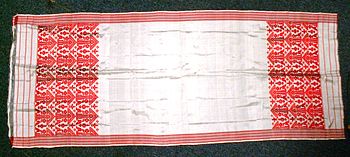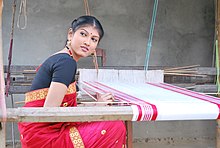HANDWOVEN GAMOSA IN ASSAM
Handwoven Gamosa, an Identity of the Assamese community. Gamosa constitutes one of the distinctive cultural identities of Assam. The Gamosa is a traditional Assamese Scarf that is a deliberation of its culture and this is highly respected and loved by Assamese people.
The best part is the unification between the diverse community groups in Assam. Various elements are being used to represent beliefs, feelings, pride, identity but the Handwoven Gamosa in various rituals and ceremonies of Assam have a long traditional background. It has been used since the Ahom Kingdom.
In the recent past, The Cabinet of Assam has marked to make it obligatory for handwoven Gamosa – the traditional multi-purpose scarf towel – to be used at government programs. Gifting an Assamese Gamosa to visitors is a tradition in Assam. Assam has more than 13 lakh looms out of the combined 28 lakh looms in the country.

Out of 13 lakh looms, 5.7 lakh are used for semi-commercial weaving, 4.5 lakh as domestic handlooms, and about 2.87 lakh for commercial weaving. The tradition is a complement to other indigenous communities.
DIFFERENT TYPES OF GAMOSA

There are nine different types of Gamosa.
1.Uka Gamosa
2.Phulam Gamosa
3.Bihuwan Gamosa
4.Toni Gamosa
5.PanToniosa
6.Anakota Gamosa
7.Telos Gamosa
8.Jor Gamosa
9.Xadharon Gamosa
USAGE OF HANDWOVEN GAMOSA IN ASSAM
Gamosa is a white rectangular section of the cloth with a red border on three sides and red woven motifs on the fourth (in addition to red, other colors are also used).
• It is used to cover the altar at the prayer hall along with scriptures.
• The Handwoven Gamosa has been used by farmers, hunters, farmers, and Bihu Dancers., The use is not restricted to this.
• It is a sign of attentiveness for elders.
Due to its unique identity, it has been approved for the geographical identity (GI)tag issued by the Geographical Indication Registry under the Department of Industry Promotion and Internal Trade, Ministry of Commerce and Industry.
Men have started wearing the Handwoven Gamosa just like the Assamese youths. Gamosa made from indigenous material is in high demand around the world. It also plays a very important role in the socio-economic development of the Assam State.
The Gamosa handloom industry of Assam has added the major source of extra income for the rural women amount to 60℅ of the total weaver population. Around 1.2 million weavers are organized into 3,744 societies registered under Handloom cooperative societies.
MAJOR CHALLENGES ASSOCIATED WITH HANDLOOM INDUSTRY OF GAMOSA and MEASURES TO PROTECT HANDLOOM INDUSTRY OF GAMOSA
Stiff Competition:
Over the years, cheaper machine-made Gamosa from Gujarat and Tamil Nadu have threatened to push Assam weavers out of business. The Government of India, breakdown of machine-made Gamosa under the Handloom (Reservation of Articles for Production) Act, 1985 extends to the whole of India.
Poor Marketing: Not adhering to sustainable marketing networks, sale and procurement is one of the major risks associated with the Handloom Industry of Gamosa. Relieving them of these uncertainties can be achieved by developing reliable and sustainable marketing networks with the involvement of the private sector.
The Handloom Industry in Assam and the oldest cottage industries in India demonstrate the richness and diversity of India all over the world. It provides livelihood to industry, Weavers, Craftsmen and demonstrates its significance in rural areas. The government of India has claimed that our North-Eastern Handloom Industry is an asset to our economy.
According to the Handloom Census of 2009-10, the top five contributor states are Assam, West Bengal, Tamil Nadu, Manipur, Andhra Pradesh constitutes 77.3% of the total handloom workers and weavers. There is a call for their distinctive and conventional product among the local people of Assam.
CONCLUSION
1.Incentives or subsidies to Gamosa Handloom Industry can be a game-changer to reach all over the world with a great source of income.
2.Provision for soft loans is viable to make the livelihoods of people affordable and achievable.
3.Proper Marketing strategy with the involvement of public and private sectors constitute the Gomosa Handloom industry to become self-independent.
4.Skill Development programs should be organized at regular intervals and awareness should be spread among the weavers to achieve realistic targets of the Handloom industry of Gamosa.
5.The Modern-technique of marketing will help to catch the sinking Handloom industry of Gamosa such as;
• Product Development
• Brand Promotion
• Advertisement
• Help of Media
The Indian Hand loom Industry is a reflection of the heritage and excellent craftsmanship of our nation. This is the right of every Indian citizen to protect the glory of India.



